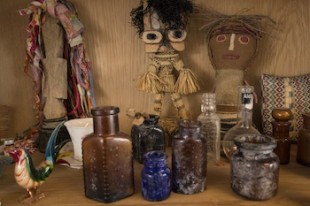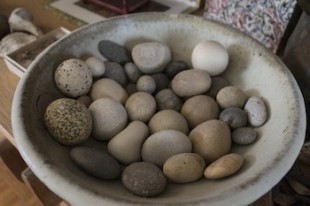About to turn 100, Rice School of Architecture’s Elinor Evans is still fired up about her art
Let’s all offer a word of thanks for Elinor Evans’ grandfather.
Nearly a century ago, he inspired the child who in turn inspired generations of Rice architecture students to see beyond surfaces to the richness of the natural world.
“He taught me to see,” she said.
These days, Evans, the Albert K. and Harry K. Smith Professor Emerita of Architecture, is an artist first. And the modest but determined Kansan is coming into her prime, with a remarkable show leading a series of events to celebrate her 100th birthday Aug. 4.

Evans, who joined Rice in 1964, used lessons provided by nature to teach her architecture students problem-solving skills. See examples of the work found in her studio below. Photo by Jeff Fitlow
Evans’ highly personal art is the focus of an exhibition titled “Some Truths to Learn From Leaves” at the Moody Gallery, 2815 Colquitt St., in Houston. The exhibition runs through Aug. 9. The Rice School of Architecture (RSA) will host a birthday brunch for Evans Aug. 3 from 11 a.m. to 2 p.m. at the Brochstein Pavilion.
In addition, the American Institute of Architects Houston will host an exhibition of works created by Evans’ students from 5 to 7 p.m. July 31 at 315 Capitol St., Suite 120, in Houston, and RSA will establish an endowment fund in her name and host a homecoming exhibition and reception from 5 to 7 p.m. Nov. 7 at Anderson Hall.
Evans taught design to RSA freshmen from 1964 to 1985 and lectured there into the ’90s. In her Houston studio, she creates art ranging from painting to collage to off-loom weaving and more. At Rice, she challenged students to look to nature to help them think about structure, as she still does in her art.
She draws a direct line from days on her parents’ ranch in Oklahoma, walking with her twin brother and their grandfather, James Monroe Evans, to her career as a teacher and life as an artist.
The grandfather “lived with us and took me every week or, in the summers, every day on walks and pointed out things about nature,” Evans said. “And it impressed me that he knew the Latin names of these plants.
“We would walk and see a small sprout coming up from the ground and then he would say, ‘We’ll look at that tomorrow,’ or ‘We’ll look at that next week,’ and when we did, it had changed. And we would follow this growth, this plant, until it matured, or until it blossomed. So I saw the whole process of becoming.
“And he pointed out the differences between one leaf and another leaf. One tree had a certain shaped leaf and another tree had another shaped leaf and so forth. This was my diet growing up, so it stuck with me somehow. And I’ve always acquired things from nature. Interesting pods and interesting seeds and so forth, and it’s been going on since the beginning of my life, and it’s just a part — a necessary part — of me.”
Evans’ winding path led her from her alma mater, Oklahoma State, which recruited her to help teach the mass of soldiers returning from World War II, to Yale, where she earned a master’s degree and studied with celebrated German-American artist Josef Albers, who “gave me another kind of critical eye,” she said. A more significant contact, she noted, was future RSA director William Caudill, who was a classmate at Oklahoma.
When Caudill recruited Evans to join the Rice faculty, he offered what she still describes as her “dream” job.
“He said, ‘Don’t use the word architecture in your class,'” Evans recalled. “My course … taught them to see and to invent and to discover their own creativity” through structuring problems that required students to gather materials that suited their solutions.
One such problem — the stick and string — became a ritual in Evans’ class. The challenge was to find “a structure that could be continuous, that could go on and on and on, repeating itself, but reinventing itself, also, in the process,” she said, showing three projects by students that “glued themselves” to her.
“Sticks could be toothpicks. They could be twigs. They could be broken weeds, stems from weeds. They could be straw. They could be all kinds of materials.”
The wonder came from looking around the classroom to see that not only had every student found a unique solution but that many had multiple solutions. “As they found one idea, they discovered they could find another idea. And that idea suggested another idea. Anyone in class could find many, many solutions to this one restricted problem,” she said.
“They say you may be lucky to have one great teacher in your whole lifetime,” said Danny Samuels ’71, a Rice professor in the practice of architecture and former student of Evans. “Well, she was that for almost everybody who had her. I feel a special relationship because I went on to teach freshman architecture for almost as long as she did. I never had the touch that she had, though.”
Samuels said creative design is now the new fashion in education, but Evans was on the case half a century ago. “Architecture in general has always been about learning how to approach a problem,” he said. “But Elinor is the paradigm of what architectural education is at its best, and a great example of how you can imbue a student with an approach that serves them for anything they might want to do in life.”
Today, Evans’ ongoing passion is her problem. She has more ideas for projects than she can possibly produce. “Ideas just come,” she said. “It’s frustrating, because I can’t make them as fast as they occur to me. It’s really difficult.
“My problem is that while I’m working on one process or idea … I get other ideas, simultaneously, many ideas, and sometimes it’s quite frustrating that I can’t do five ideas at the same time.”
Betty Moody, owner and director of the Moody Gallery, compared seeing Evans’ studio for the first time to The Secret Garden: “It’s like walking through this portal into another kind of world. It’s wonderful.”
In that visit, she immediately took a liking to Evans’ leaf collages, which will be offered for sale at the exhibition. (Evans is donating her proceeds to the RSA endowment in her name.) “I was quite honestly unprepared for how exquisite they were,” Moody said. “They’re beautiful. They’re simple. They’re spare in some cases, but they’re real interesting, complex compositions, and there are some great combinations of colors.
“It’s a privilege to show her work,” she said. “Elinor is a clear thinker; she has a great eye, and there’s a freshness about her collages that I really love.”
Evans also has a clear memory. RSA alumna and designer In Shik Lee ’83, who is helping organize the events, recalled watching a documentary about the Dust Bowl when it occurred to her Evans would know something about that. “So I asked her,” Lee said. “She said, ‘Oh, yes,’ and started telling me about the routine when she was a teenager, putting wet towels around the doors and windows every night to keep dust out of the house. She remembers everything.”
Evans attributes her memory to her tenacious creative pursuits. It seems every one of the overwhelming number of perfectly organized objects in her studio – some by students, most by her — brings forth a story.
Showing visitors around her studio, she pointed to a large basket of smooth rocks she took from a Massachusetts beach over the protests of a friend, who said they belonged there. “I understood what she was saying. But I still took them,” she laughed.
She retrieved another basket and displayed a most orderly collection of hundreds of aluminum pull-tabs. Decades ago, Houston’s streets sloped inward and the centers provided ripe pickings for Evans, who said she surveyed them for “as found” objects of interest.
Then there are the writing tools made by students who were given a problem: Find or fashion a device for making its own unique calligraphic mark on paper. The collection includes matchbooks, toothpicks, twigs and other bric-a-brac, each blackened on one end as proof of their success.
Evans said she never stopped evolving her approach to teaching design. “I didn’t come to Rice with a ready-made course. I came to Rice with an attitude toward teaching and an attitude about the kind of problems that I gave,” she said.
“My course was an organic thing. I worked at it every year, and I added new experiences. And I added new attitudes for myself about old experiences, so that I was always making and remaking the course. And to this day, when I’m not teaching, I’m still finding myself remaking the course – or making it better, finding another problem which would offer another experience and another kind of structuring.”
She fears digital tools don’t offer anything close to the same experience. “My friends are always pushing me to hurry up and go get a computer,” she said. “Hurry and go and do this and do that. But I don’t have need for it yet, and it would steal from my time of working. And my time is limited. So I want to continue making.
“I haven’t been in an architectural classroom for some time, so I haven’t seen how the students with the new technology can get acquainted with themselves, how they can discover a broad way of looking at the world, a broad way of looking at nature,” she said. “They’re not able, with the tools they’re using now, to make the kind of discoveries we used to make.”
So forget the electronics. She’d rather do what comes naturally.
“I’ve had many students say over and over to me, ‘You changed my way of looking at life,'” Evans said. “I didn’t set out to change anybody’s way of looking at life. I wouldn’t know how to do it. But in the process of hunting for solutions to the ideas I presented them, they somehow have sewn it into their lives, into their way of looking.
“I teach them to see.”








Elinor Evan’s life is a creative inspiration. Along with my grandmother who is 96 and active, these women light up the tunnel of life enticing us to continue to discover and marvel along the way. Happy birthday and many more!